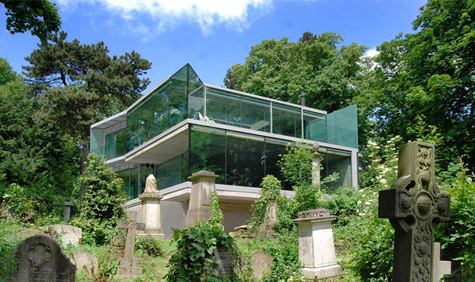Interactive floorplan: 85 Swains Lane

When Eldrige Smerin Architects were approached by a client with a house in Highgate, it was clear that this was a site without equal.
Literally perched on the edge of the historic Victorian cemetery, the site on Swains Lane was occupied by an existing steel-framed house designed by the modernist John Winter, alongside a small cluster of other contemporary residences . Winter's pavilion was striking but elderly. 'Replacing a John Winter house is not a decision to be taken lightly,' the architects noted, but they were especially pleased when their replacement design earned the older architect's approval.
The new house is four-storeys tall, occupying the same footprint as Winter building. It is an altogether different prospect. From a street elevation that is plain and discrete, with an expansive panel of frosted privacy glass hinting at the glassy wonders within, the visitor steps into a light-filled world of technology and visual drama.
The concrete-framed house is effectively a pavilion that opens up to the verdant expanse of the cemetery, a romantic landscape of mossy tombstones and crooked monuments. Although open to the public during the day, the cemetery is abandoned at night, meaning that the expansively glazed living area on the upper floor is almost entirely private.
The detailing is impressive, from the soft grey concrete walls, with crisp and precise shuttering, to the frameless structural glass components that form the cemetery-facing façade. A green sedum roof and stone cladding keep energy consumption low, especially helpful given the hugely complex AV set up by SMC Systems Integration threaded through the house, culminating in a spectacular Music Room.
Other gadgetry abounds, including an opening rooflight above the top floor kitchen, a suspended wood-burning stove with a flue that plunges through two levels, and glass desks and shelves in the study area.
Wallpaper* Newsletter
Receive our daily digest of inspiration, escapism and design stories from around the world direct to your inbox.
Ellie Stathaki is the Architecture & Environment Director at Wallpaper*. She trained as an architect at the Aristotle University of Thessaloniki in Greece and studied architectural history at the Bartlett in London. Now an established journalist, she has been a member of the Wallpaper* team since 2006, visiting buildings across the globe and interviewing leading architects such as Tadao Ando and Rem Koolhaas. Ellie has also taken part in judging panels, moderated events, curated shows and contributed in books, such as The Contemporary House (Thames & Hudson, 2018), Glenn Sestig Architecture Diary (2020) and House London (2022).
-
 All-In is the Paris-based label making full-force fashion for main character dressing
All-In is the Paris-based label making full-force fashion for main character dressingPart of our monthly Uprising series, Wallpaper* meets Benjamin Barron and Bror August Vestbø of All-In, the LVMH Prize-nominated label which bases its collections on a riotous cast of characters – real and imagined
By Orla Brennan
-
 Maserati joins forces with Giorgetti for a turbo-charged relationship
Maserati joins forces with Giorgetti for a turbo-charged relationshipAnnouncing their marriage during Milan Design Week, the brands unveiled a collection, a car and a long term commitment
By Hugo Macdonald
-
 Through an innovative new training program, Poltrona Frau aims to safeguard Italian craft
Through an innovative new training program, Poltrona Frau aims to safeguard Italian craftThe heritage furniture manufacturer is training a new generation of leather artisans
By Cristina Kiran Piotti